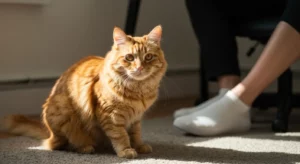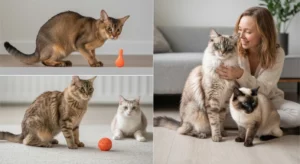I can’t remember a time when my life wasn’t filled with the pitter-patter of paws, the soft rustle of scales, or the gentle bubbling of a fish tank. From my childhood home, which was a revolving door for every stray in the neighborhood, to my years working as a vet tech and volunteering at the local shelter, animals have been my constant companions. They’ve been my confidants, my jesters, and my greatest teachers.
But I also know the modern world doesn’t always feel compatible with pet ownership. Our schedules are packed, our apartments are small, and our energy is often depleted by the end of the day. The desire for a pet often comes with a heavy dose of guilt: “Do I really have the time?”
I’ve asked myself that question many times. And through my journey, I’ve learned that the answer is almost always yes—if you find the right pet for your lifestyle. The term “low-maintenance” gets thrown around a lot, but it’s a bit of a myth. No pet is “no-maintenance.” Every living creature deserves our time, care, and respect. But some animals have needs that align more gracefully with a busy schedule. Their care is more about predictable routines than constant, moment-to-moment attention.
This isn’t a list of facts I pulled from a textbook. This is my story, shared through the animals who have left their paw prints, fin-flutters, and tiny footprints all over my heart. These are the companions who taught me that a full life and a full heart have room for both ambition and animal affection.
-
The Quiet Dignity of an Adopted Adult Cat
Kittens are adorable, chaotic little balls of energy. I’ve fostered dozens, and while I adore them, they are the opposite of low-maintenance. They’re toddlers with claws who need constant supervision. That’s why, when I finally decided to adopt a cat for myself during a particularly demanding phase of my career, I walked right past the kitten room at the shelter.
That’s where I met Jasper. He was a seven-year-old domestic shorthair, a handsome tabby with a nick in one ear and the most world-weary expression I’d ever seen. His kennel card said he was surrendered because his family had a new baby and “no time.” He sat curled in a tight ball at the back of his cage, ignoring everyone who walked by. He didn’t try to sell himself. He was simply… existing.
I sat with him for an hour, just talking to him through the wire. He never moved, but his ear would twitch when I spoke. I took a chance. For the first two weeks at my apartment, he lived under my bed. I started to worry I’d made a mistake. But I just kept to a routine: fresh food and water in the same spot, a clean litter box, and quiet evenings reading on the floor near the bed. On day 15, I woke up to a faint pressure on my legs. It was Jasper, asleep at the foot of my bed. It was one of the most triumphant moments of my life.
What I learned: An adult cat is often the perfect companion for a busy professional. Jasper didn’t need me to entertain him; he was a master of napping and window-gazing. He was already litter-trained and past the destructive scratching phase. Our relationship was built on quiet companionship. He was my silent, purring roommate during late-night work sessions and my warm, fuzzy greeter when I came home, exhausted. If you’re busy, don’t overlook the quiet souls in the adult cat section of your local shelter. Their personality is already formed, and often, all they need is a peaceful place to land.
-
My Jewel of the Desk: The Personality of a Betta Fish
Before you roll your eyes, hear me out. The common image of a Betta fish—a sad creature in a tiny, unheated vase—is a tragedy and a complete misrepresentation of these incredible animals. When cared for properly, Bettas are not just decorative; they are interactive, intelligent little beings with huge personalities.
My first “real” Betta was a stunning cobalt blue male I named Neptune. I was working from home and wanted a little life on my desk that wouldn’t demand walks or litter box scooping. I did my research and got him a 5-gallon, heated, filtered tank with live plants. It was a tiny, self-contained ecosystem, and it was the best decision I ever made.
Neptune wasn’t just a fish; he was a colleague. He would flare his magnificent fins at my pen when I moved it too fast. He would wiggle with excitement—a full-body “dance”—when he saw me reach for his food container. I even taught him to swim through a small hoop for a bloodworm treat. He learned to recognize me, and his presence was an immense source of calm during stressful conference calls. The maintenance? Five minutes a week to do a partial water change and a few seconds each day to feed him. That’s it.
What I learned: The key to a low-maintenance Betta is the initial setup. Invest in a proper tank (5 gallons minimum), a gentle filter, and an adjustable heater. Once that’s done, the daily care is almost nothing, but the reward is immense. They offer the beauty of an aquarium without the cost, space, and labor of a massive tank. They are the perfect pet for a small apartment or a home office.
-
The Secret Nightlife of Lenny the Leopard Gecko
I’ll admit, I was never a “reptile person.” The idea of feeding live insects to a pet seemed like a bridge too far. But a friend who was moving abroad couldn’t take her Leopard Gecko, Lenny, and I agreed to pet-sit him for a few weeks. Those weeks turned into a permanent adoption.
Lenny completely changed my perception of reptiles. Because he was nocturnal, our schedules were perfectly aligned. While I was at work or running errands during the day, he was snoozing peacefully in his favorite hide—a little hollowed-out log. When I’d get home and start winding down for the evening, he would start to wake up. It was like we were on the same shift.
His care became a calming ritual. A couple of times a week, I’d use tongs to offer him calcium-dusted crickets or mealworms. Watching him hunt with such focus was fascinating. He had a surprising amount of personality. He would climb onto my hand and just sit there, soaking up my warmth. He never made a sound, there was no smell (as long as I spot-cleaned his “bathroom” corner), and he didn’t need my affection to be happy. He was perfectly content in his own little world, and he allowed me a window into it.
What I learned: For a busy person, a Leopard Gecko is a phenomenal choice. Their needs are very specific—they require an under-tank heater to create a proper heat gradient, not a heat lamp—but once the habitat is set up correctly, the daily maintenance is incredibly low. They are clean, quiet, and don’t suffer from separation anxiety. They teach you a different kind of animal appreciation, one based on observation and respect for a creature so different from ourselves.
-
Sky and Ocean: The Built-in Companionship of Budgies
A single bird can be a very demanding pet. They often bond intensely with one person and can become distressed and destructive if left alone for long periods. I learned this the hard way with a cockatiel early in my life. So, when I later felt the pull to hear the cheerful sound of birdsong in my home again, I knew I had to do it differently. I adopted a bonded pair of budgies (parakeets).
Sky and Ocean were inseparable. One was a brilliant blue, the other a cloudy white. Their cage was their kingdom, and they spent their days preening each other, chattering back and forth, and playing with the bells and swings I’d hung for them. Their cheerful chirps became the soundtrack to my mornings and evenings. It was like having a living, breathing wind chime.
Because they had each other, their social needs were largely met. They didn’t scream for my attention every time I left the room. My role was that of a benevolent caretaker: I provided fresh seed, water, and a daily chop of veggies, and I cleaned their cage thoroughly once a week. In return, they filled my apartment with life and color. Their interactions were endlessly entertaining, a tiny soap opera playing out in my living room.
What I learned: If you love birds but work long hours, always get a pair. They will keep each other company, reducing the stress and loneliness that a single bird can experience. The daily care is routine-based and takes only a few minutes. While they may not be as cuddly as a single, human-bonded bird, they offer companionship and joy in a way that perfectly suits a busy life.
-
The Joyful “Wheeks” of Two Guinea Pig Brothers
There is no sound on earth quite as joyful as the “wheek” of a guinea pig who hears the rustle of a vegetable bag. It’s a sound of pure, unadulterated delight. My first foray into the world of cavies was with two brothers from a local rescue, Pip and Squeak. They were a bonded pair of Abyssinians with wild, rosette-patterned fur that stuck out in every direction.
Guinea pigs are often marketed towards children, but I found them to be ideal pets for my adult, working lifestyle. They don’t need to be walked. Their large C&C (Cubes and Coroplast) cage was their entire world, a safe space where they could run, hide in their fleece tunnels, and nap. They are crepuscular, meaning they are most active during dawn and dusk—perfectly bookending a standard 9-to-5 workday.
My routine was simple. In the morning, I’d refresh their hay (the most important part of their diet!), pellets, and water. In the evening, after work, was the highlight of their day: veggie time! Hearing them start to wheek and “popcorn” (jump straight up in the air with excitement) as I chopped carrots and bell peppers was the best stress-reliever I could ask for. The biggest chore was a full cage clean-out once a week, but even that became a meditative process.
What I learned: Like birds, guinea pigs are social and must be kept in pairs or groups. Their care is entirely routine-based and fits neatly outside of work hours. They are gentle, communicative pets whose needs are straightforward. The key is providing a large enough habitat and an unlimited supply of high-quality timothy hay. They are all the fun of a rodent without the nocturnal noise of a hamster on a wheel.
-
Why a Senior Dog Was My Easiest Canine Companion
Now, I know what you’re thinking: “A dog? On a low-maintenance list?” This is the one that requires the biggest asterisk, but it comes from my most profound experience in pet ownership. After years of having only smaller pets, I felt ready for a dog, but knew a puppy was out of the question. My job was demanding, and I couldn’t commit to the chaos of house-training and obedience classes.
So, I went to the shelter with a specific request: “Show me your calmest, oldest, hardest-to-adopt dog.” They led me to Barnaby. He was a 10-year-old terrier mix with a graying muzzle, cloudy eyes, and the calmest demeanor I’d ever encountered. He’d been at the shelter for six months.
Adopting Barnaby was life-changing. He was already house-trained. He was past the stage of chewing furniture. His energy level was a perfect match for mine. He needed two things: short, leisurely strolls around the block twice a day, and a soft bed (or, preferably, my lap). He spent about 22 hours a day sleeping. He didn’t demand games of fetch; he just wanted to be near me. He was pure, uncomplicated companionship.
What I learned: A puppy is a massive, life-altering commitment. An older dog, however, can be surprisingly low-maintenance. At a shelter, what you see is what you get. The staff can tell you if the dog is good with being left alone, if they’re a barker, or if they’re a couch potato. For a busy person who wants a canine friend, a senior dog is a gift. You get to skip the difficult puppy years and give a deserving soul a comfortable, loving retirement home. Barnaby taught me that “maintenance” is relative, and sometimes the pets that ask for the least give the most in return.
-
The Zen Masters of the Pet World: My Fascinating Snail Tank
This is my ultimate recommendation for the person who says they have absolutely, positively no time for a pet. After my beloved Betta fish passed away, his little 5-gallon tank sat empty on my desk for months. I missed having life there, but I wasn’t ready for another fish. On a whim, I bought three Nerite snails and a Golden Mystery Snail.
I expected them to be… well, boring. I was so wrong. They became my tiny Zen garden. I would find myself getting lost watching them methodically clean algae off the glass, their little mouths working diligently. The Mystery Snail, who I named Archimedes, would climb to the top of the tank, let go, and parachute gracefully back down to the substrate. It was hilarious and oddly beautiful.
The care commitment was as close to zero as you can get. I dropped in an algae wafer or a slice of blanched zucchini twice a week. I did a small water change every other week. That was it. No noise, no demands, no vet bills. Just a silent, peaceful, and surprisingly captivating micro-world on the corner of my desk. They were living art.
What I learned: Pets don’t have to be furry or cuddly to bring joy and reduce stress. For the busiest of the busy, aquatic snails are a perfect entry point. They prove that you can be a responsible, caring pet owner even if you only have a few minutes to spare each week. They taught me to appreciate the small, quiet wonders of the natural world, right in my own home.
Finding the right pet is a journey of self-reflection. It’s about honestly assessing your time, your home, and your energy, and then finding a creature whose needs you can not only meet but exceed. Whether it’s a dignified old cat or a humble, hardworking snail, there is a companion out there for you. The love they give in return for a little food, a safe space, and a bit of your heart is, I promise, worth every single second.












